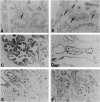Implication of cell kinetic changes during the progression of human prostatic cancer
- PMID: 9816006
- PMCID: PMC4086477
Implication of cell kinetic changes during the progression of human prostatic cancer
Abstract
The daily percentage of cells proliferating and dying were determined for normal, premalignant, and cancerous prostatic cells within the prostate as well as for prostatic cancer cells in lymph node, soft tissue, and bone metastases from untreated and hormonally failing patients. These data demonstrate that normal prostatic glandular cells have an extremely low but balanced rate of cell proliferation and death (i.e., both <0.20%/day). This results in a steady-state, self-renewing condition in which there is no net growth, although the glandular cells are continuously being replaced (i.e., turnover) every 500 +/- 79 days. Transformation of these cells into high-grade prostatic intraepithelial neoplastic cells initially involves an unbalanced increase in the daily percentage of cells proliferating versus dying, such that net continuous growth occurs (i.e., mean doubling time, 154 +/- 22 days). As these early proliferation lesions continue to grow into late stage high-grade prostatic intraepithelial neoplastic cells, the daily percentage of cells dying increases further to a point equaling the daily percentage of proliferation. This results in cessation of net growth while inducing a 6-fold increase in the turnover time of these cells (i.e., 56 +/- 12 days), increasing their risk of further genetic changes. The transition of late stage high-grade prostatic intraepithelial neoplastic cells into localized prostatic cancer cells involves no further increase in proliferation but a decrease in death resulting in net continuous growth of localized prostatic cancers with a mean doubling time of >/=475 days. As compared to localized prostatic cancer cells, metastatic prostatic cancer cells within lymph nodes or bones of untreated patients have an increase in daily rate of proliferation coupled with a reduction in their daily percentage of cell death, producing net growth rates with a mean doubling time of 33 +/- 4 days and 54 +/- 5 days, respectively. Remarkably, there is no further increase in proliferation in hormonally failing patients, but instead an increase in the daily percentage of androgen-independent prostatic cancer cells dying within soft tissue or bone metastases. These changes result in doubling times which are two to three times longer (i.e., 126 +/- 21 and 94 +/- 15 days) in these lymph node and bone metastatic sites, respectively, compared to similar sites in hormonally untreated patients. These data demonstrate that the daily percentage of proliferation for either androgen-dependent or -independent metastatic prostatic cancer cells is remarkably low (i.e., <3. 0%/day), consistent with why antiproliferative chemotherapy has been of such limited value against such metastatic cells. These results also suggest that prostatic carcinogenesis starts in the second to third decade of life and may require over 50 years for progression to pathologically detectable metastatic disease.
Figures

References
-
- Kyprianou N, English HF, Isaacs JT. Programmed cell death during regression of PC-82 human prostate cancer following androgen ablation. Cancer Res. 1990;50:3748–3753. - PubMed
-
- Isaacs JT, Lundmo PI, Berges R, Martikainen P, Kyprianou N, English HF. Androgen regulation of programmed death of normal and malignant prostatic cells. J. Androl. 1992;13:457–464. - PubMed
-
- Crawford ED, Eisenberger MA, McLeod DC, Spaulding J, Benson R, Dorr FA, Blumenstein BA, Davis MA, Goodman PJ. A control randomized trial of Leuprolide with and without flutamide in prostatic cancer. N. Engl. J. Med. 1989;321:419–424. - PubMed
-
- Isaacs JT, Schulze H, Coffey DS. Development of androgen resistance in prostatic cancer. In: Murphy G, Khoury S, Kiess R, Chatelair C, Denis L, editors. Prostate Cancer, Part A: Research, Endocrine Treatment, and Histopathology. Alan R. Liss, Inc.; New York: 1987. pp. 21–31. - PubMed
-
- Isaacs JT. Hormonally responsive vs unresponsive progression of prostatic cancer to antiandrogen therapy as studied with the Dunning R-3327-AT and G rat prostatic adenocarcinoma. Cancer Res. 1982;42:5010–5014. - PubMed
Publication types
MeSH terms
Grants and funding
LinkOut - more resources
Full Text Sources
Other Literature Sources
Medical
Research Materials
